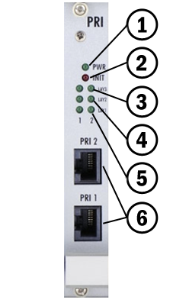PRI Board
Board Description
The PRI board contains one or two (depends on the part number) ISDN interfaces and PCM bus timing circuits. PRI 1 is designed as an internal interface (with an activated LCR function) and PRI 2 as an external interface (all calls from the port are always routed to PRI 1). The interface can work in the MASTER or SLAVE mode (set the PRI 1 mode using the web interface and PRI 2 has always the opposite mode). The output can be configured as TERMINAL (TE) or NETWORK (NT) by jumpers (switching of wires – for software switch you have to use the web interface!). The settings of these jumpers HAVE TO match the PRI configuration – two NT and TE modes will cause malfunction of the PRI board or back-up connection* ! The board is designed on a 4-layer PCB of the size of 160x100mm. There are also 5 (or 8 in 2ISDN PRI) board status indicators, which are located on the front panel.
- The PRI board contains four switches (can be deactivated by jumpers), which provide hardware connection between PRI 1 and PRI 2 in case the system is switched off or inoperative.
- Board supply indication
- Shining: Switched on
- Flashing: Board in the sleep mode
- Board initialisation or error state
- Shining (up to 1 minute): Firmware upgrading
- Continuous shining or flashing: Board initialisation failure
- Status of ISDN layer 3 on PRI 1/2 interfaces
- Shining: One or more calls are connected over selected interface
- Flashing: B-channel in restartLight off: No active call
- Status of ISDN layer 2 on PRI 1 (2) interfaces:
- Shining: Layer 2 successfully established
- Flashing: Layer 2 in the establishing process
- Light off: Layer 2 disconnected
- Status of ISDN layer 1 on PRI 1 (2) interfaces:
- Shining: Layer 1 successfully established
- Flashing: Layer 1 in the establishing process
- Light off: Layer 1 disconnected
- Physical RJ-45 connectors for ISDN PRI 1 and PRI 2 interfaces. Before you plug in your ISDN connection please check whether the wiring configuration matches the ISDN connection requirements!
Tip
- The LED statuses provide basic information on the ISDN interface only. For details on the ISDN interface state refer to the web interface.
Configuration Jumpers
There are three configuration jumper blocks on the PRI board. JP2 and JP3 are used for hardware switching of the ISDN PRI connector into the TE/NT configuration. This operation means only swapping of the transmitting and receiving connector pairs, the interface configuration must be made using the web interface. With jumper JP4 you can activate/deactivate the back-up connection between PRI 1 and PRI 2 in case the system is switched off or the PRI board is not handled by system.
Warning
- The back-up connection (JP4) works only in case the wire settings of PRI 1 (JP3) and PRI 2 (JP2) are set in the opposite way (e.g. PRI 1 as NT, PRI 2 as TE).
Note
- Boards with just one PRI interface (1PRI boards) have the same settings as the PRI 1 interface on 2PRI boards. And there is no back-up connection (JP4) either.
Positions of Tx and Rx Wires
Example of Connection with 1ISDN PRI Board
Example of Connection with 2ISDN PRI Board
Warning
- The ISDN port mode (TE or NT) and synchronisation type (Master/Slave) must be different on the PBX (PSTN) and on the gateway. The TEI number must have the same value (default = 0).

